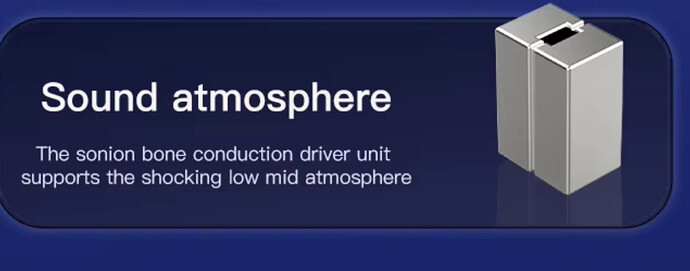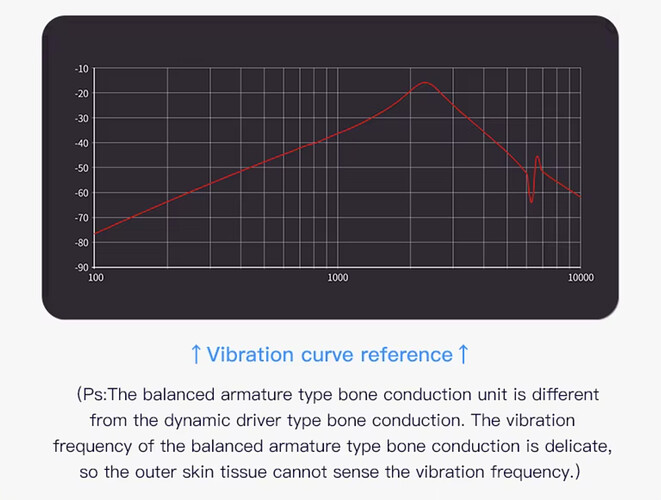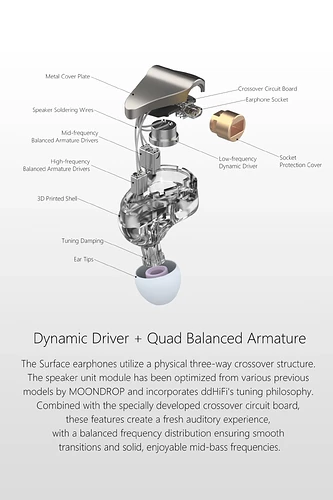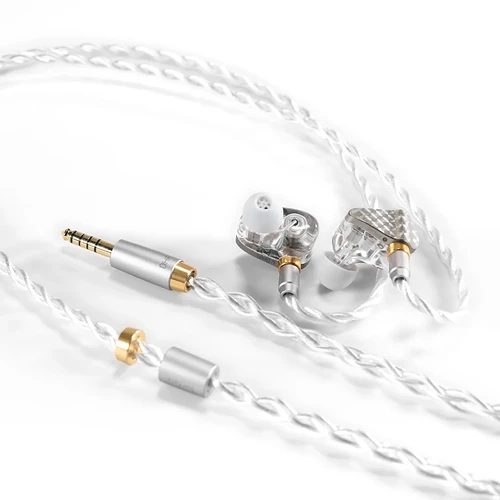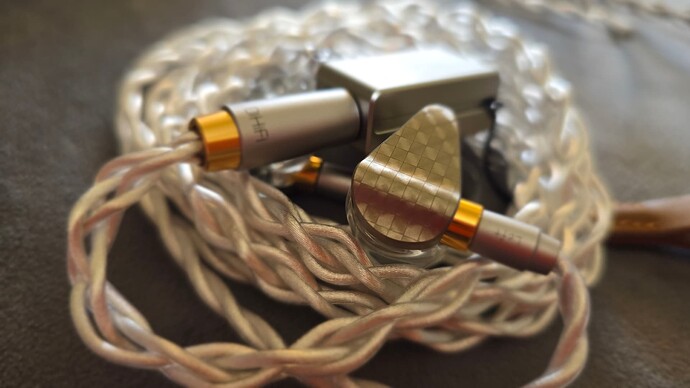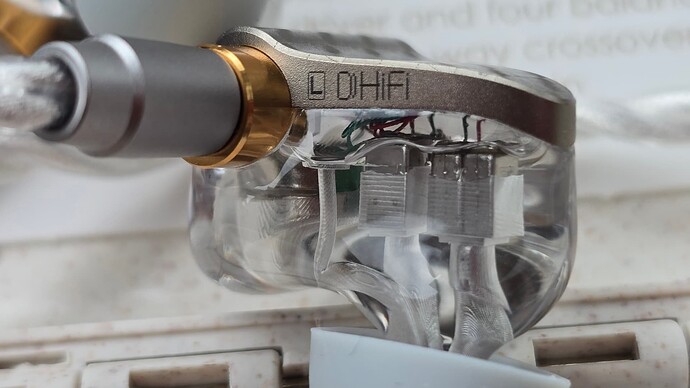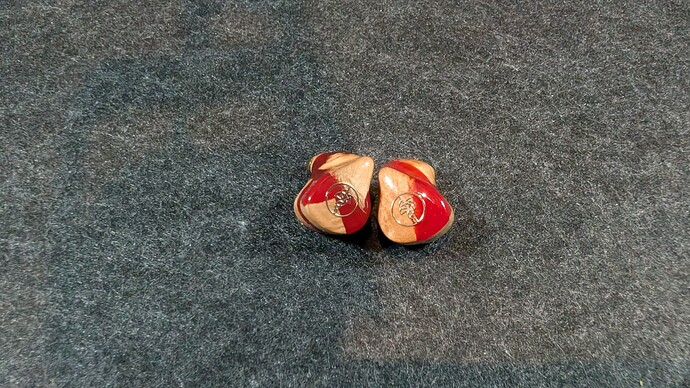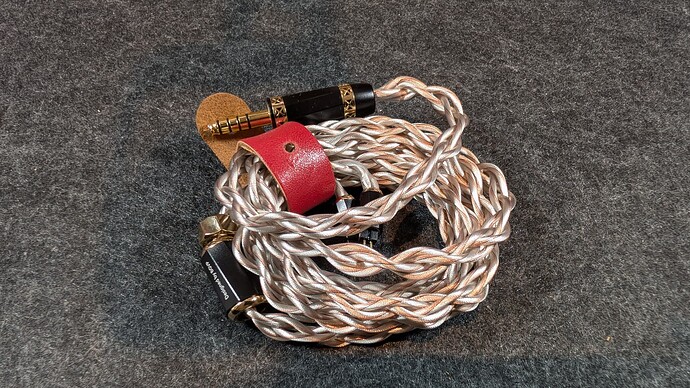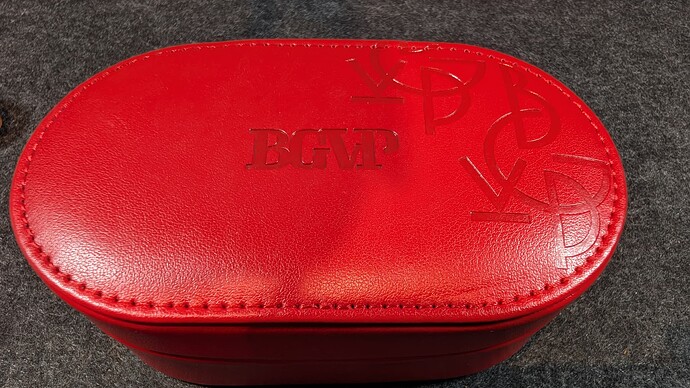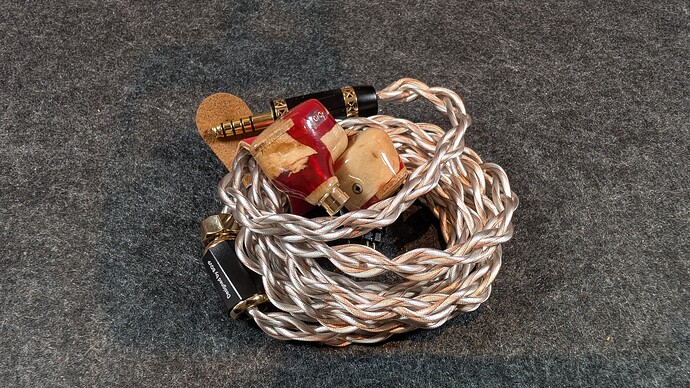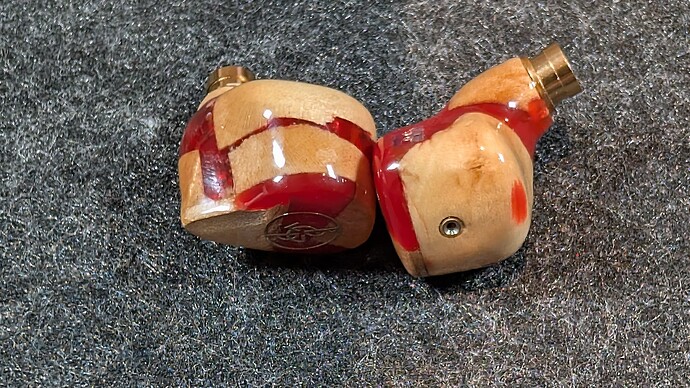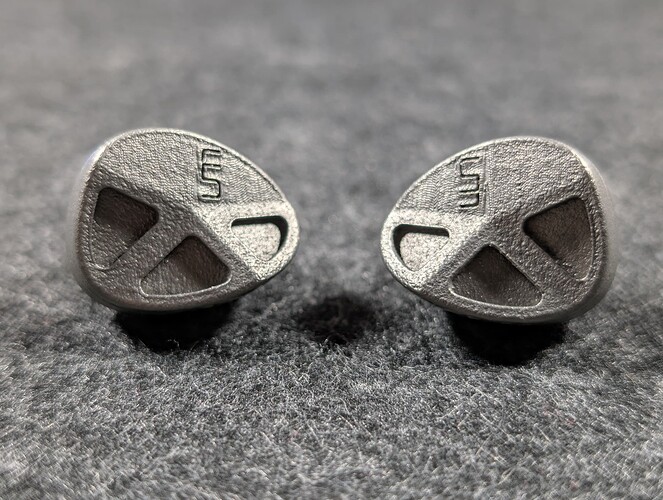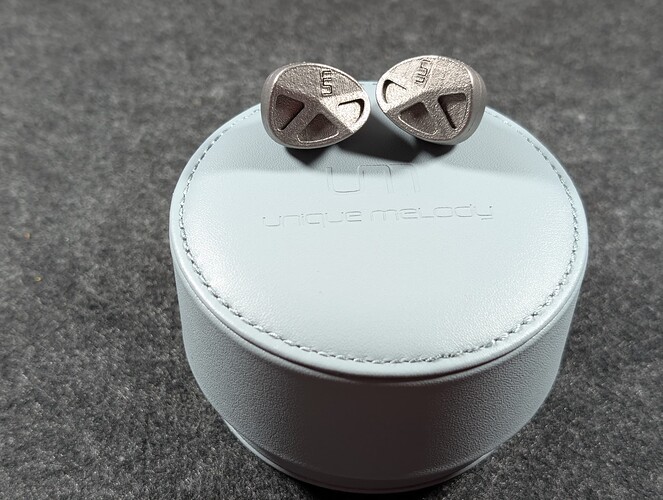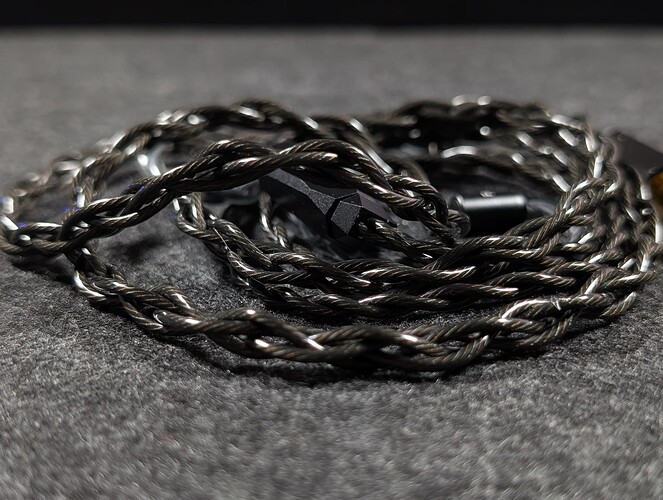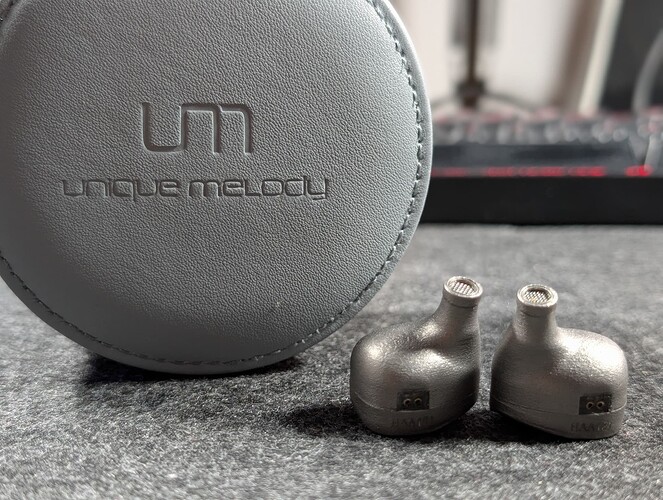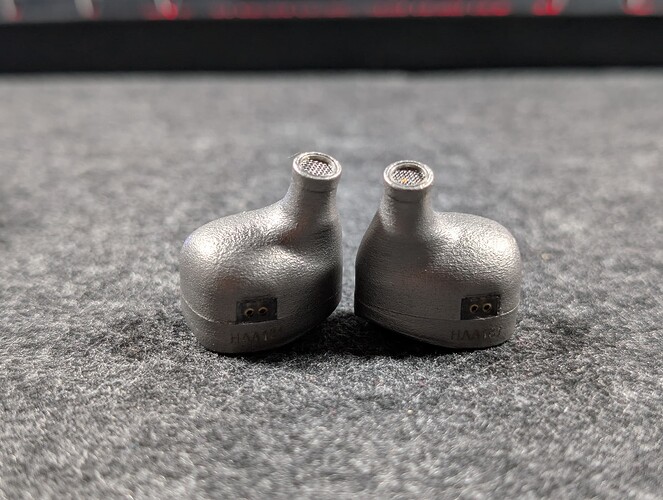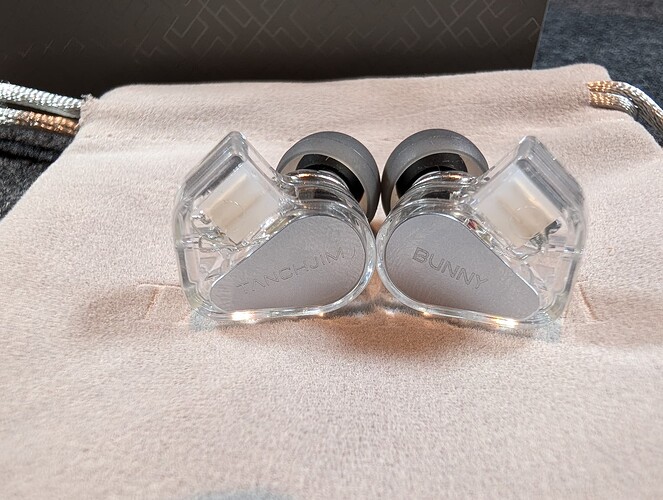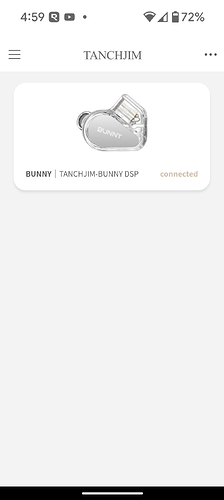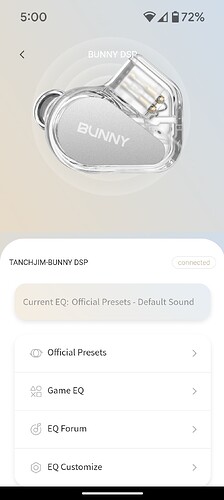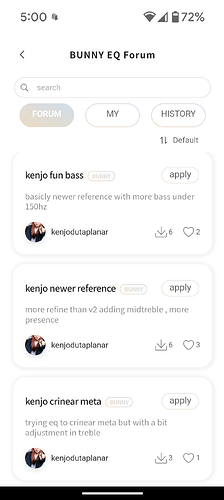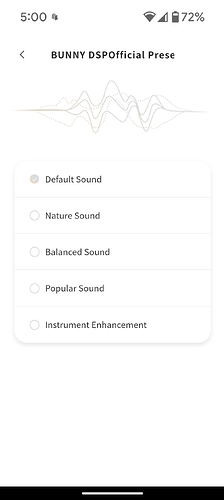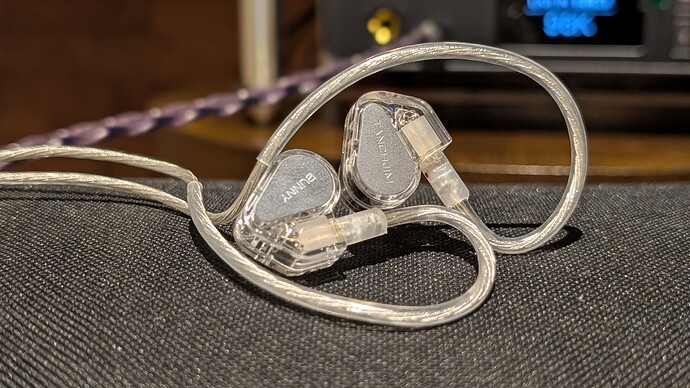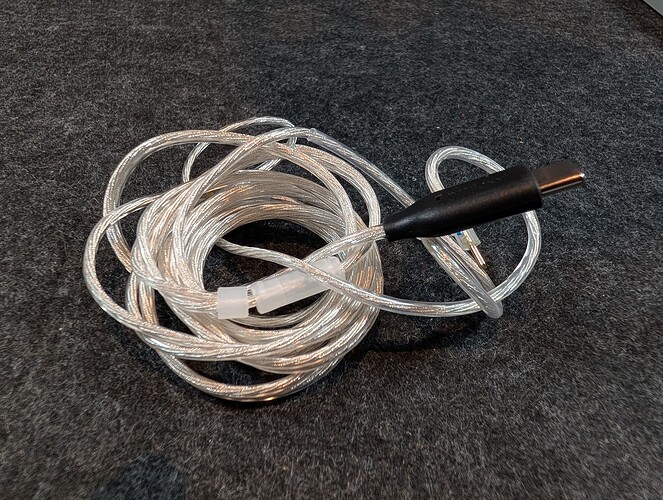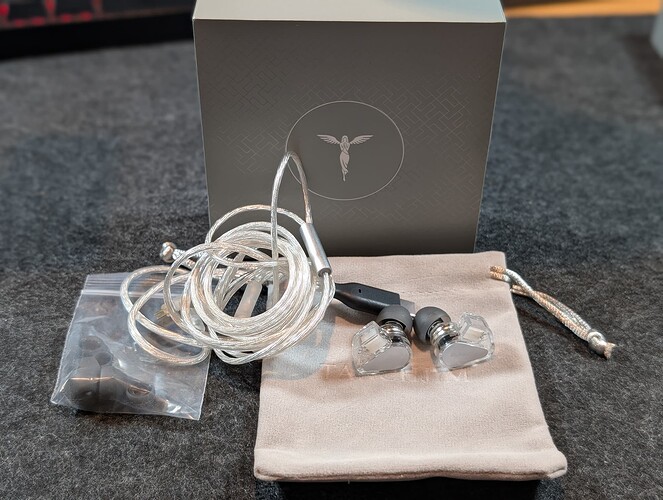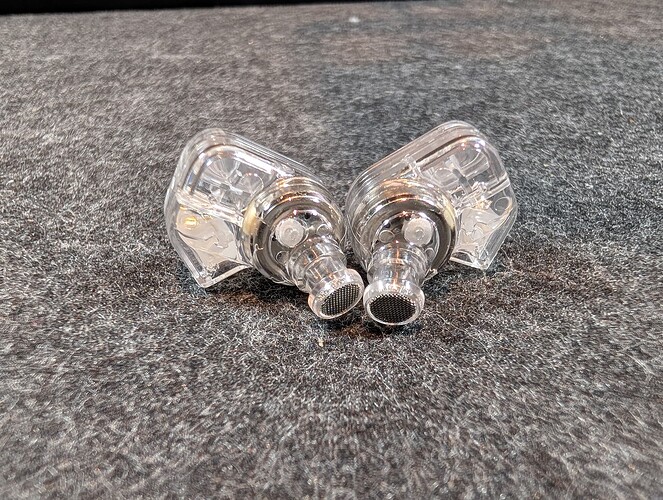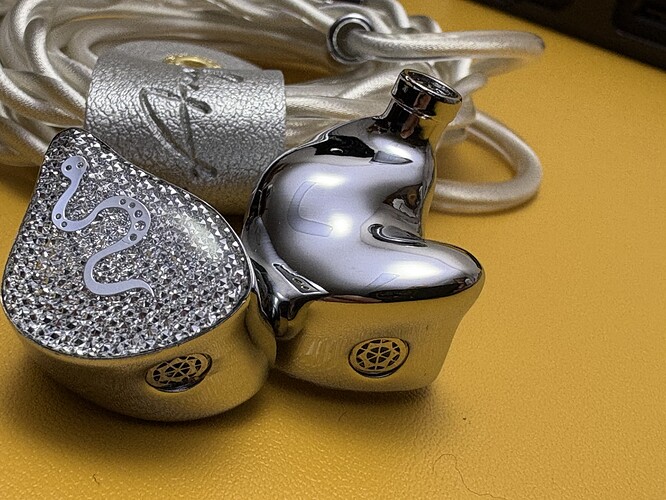Likely because the Sonion BC isnt a bass shaker and wont really stand out from the other drivers there afaik.
Yep. No feel but no benefit to the mids either to my ear.
Yeah its a weird driver to me tbh…
I was hoping to hear that one as well sounds like a more bassy IEM and more in like with my preferences.
Sorry to hear the BC let ypu down a bit on that set I find this Sonion BCD can be hit or miss for some people.
ddHiFi Surface 1+4 Hybrid $279.99
Title says it all!
![]() Incredibly Cohesive
Incredibly Cohesive
![]() Smooth and Analoge
Smooth and Analoge
![]() Detailed and Resolving
Detailed and Resolving
![]() Musical beyond belief
Musical beyond belief
![]() Simply Gorgeous Shells
Simply Gorgeous Shells
![]() Amazing Case $ Accessories beautiful unboxing
Amazing Case $ Accessories beautiful unboxing
![]() Price to Performance off the charts
Price to Performance off the charts
![]() Cable is a bit stiff.
Cable is a bit stiff.
Wow! High praise via pros/cons list!
BGVP Phantom SE – Vibrant & Musical
Preamble:
BGVP has been around for some time churning out many respectable sets to grace our hungry ears. While not as prominent on the scene as some others, IMHO they should be. The Phantom comes in somewhere in the middle of their product line and at $1099 USD is priced accordingly.
Each gorgeous shell includes a driver compliment of two dynamic drivers, two balanced armatures, two EST drivers and two bone conductor drivers. Unlike many other iem companies, BGVP does not shy way from naming the manufacturers of these components , BGVP listing Sonion and Knowles as the sources of the EST and BA drivers used. All of these drivers are under control of a 5 way crossover as well.
As I have said in previous reviews, it is NOT the type and manufacturer of drivers that matters but their implementation and tuning. BGVP has triumphed here and done a standout job in integrating all these different technologies into an iem that truly sings.
The Phantom SE is only moderately easy to drive and definitely benefits from a more capable source both with respect to resolution and driving power. The Phantom’s sound comes alive when adequately driven but may suffer when not. Tip selection should also not be overlooked and my listening was done using wide bored tips with a moderate stem length.
SPECS:
2x Sonion EST (Treble)
1x Sonion BA (Mids)
1x Knowles BA (Highs/Mids)
2x graphine Dynamic Drivers
2x Sonion Bone Conductor Drivers
Sensitivity: 107db SPL/mW
Impedance: 12ohm
Build & Fit:
The BGVP Phantom SE is one beautiful IEM. Pictures do not really do it justice as this iem, on top of having a flawless finish, is an eye catcher. The highly polished resin shells are topped of on one end with a gold nozzle and at the other end capped with tastefully done branding also coloured gold.
The Phantom SE is a medium sized iem with a prominent nozzle. A proper fit was easy to realize with some attention having been paid to tip selection to both achieve a good seal and better sound synergy.
I did not have the full retail kit for this review but did have the stock cable which was outstanding in its appearance and apparent quality. The included branded case was also a standout being of high quality with charming looks and finish. . BGVP definitely didn’t cut corners with the Phantom SE with the iem itself or the included accessories. All exude a high quality look and feel commensurate with its asking price. Well done!
SOUND:
Bass:
Bass is tight, clean and does go fairly deep. There is just a slight focus on the sub-bass vs the mid-bass here. The presentation here is more about quality as opposed to quantity. No the Phantom SE is NOT bass shy, but bassheads will have to look elsewhere. Those who enjoy musicality though will find much to like.
The bass does not overshadow the mid-range and yet it’s there providing a foundation. There is a richness to the tone here which could be attributed to the bone conductor drivers working in concert with the quality dynamic drivers.
Listening the “18th Street Lounging” by Marcus Miller the bass was overall satisfying but with just a few small caveats. Decay could be a touch longer and the bass here is more on the dry side. Still it is quite musical and those nitpicks did not detract from the overall experience in a way that is distracting. Listening to “Angel” by Massive attack the same characteristics were heard with nice control and adequate texturing if a little dry.
The mid-bass is quick and taught with good detail. There is little if any midrange bleed here the bass staying in its lane. The low end of the Phantom SE does satisfy but it’s tuned for musicality as opposed to over the top slam and power.
Midrange:
The midrange is open with good clarity and detail. There is a mix of both macro and micro details heard here. The lower mids do have a touch of warmth which added some meat to male vocals. The upper mids do see some pinna gain but there is no harshness. Female vocals are more forward than male though being more immediate in the mix while neither are out front. Vocals are also relayed with great coherence.
Note weight is acceptable but on some occasions I would have preferred more. This did affect timbre which again is good but at times the lack of note weight detracted from being perfect.
Layering and separation is quite good even on busier tracks. When listening to “Beautiful Lie” by Vick Lavender I was more than please with the Phantom SE’s poise and ability to present all the elements in their own space. Transients and dynamics were also managed well sounding natural.
The BGVP Phantom SE has a midrange while not perfect is suited to long listening sessions. It excels at all genres of music while being forgiving to less than well recorded tracks.
Treble:
The treble is well extended, clean with great detail and control. Fatigue free with no harshness the treble rounds out the performance of the Phantom in a beautiful way. Listening to “Vanston Place 12am” by Ronny Jordan there was ample air and sparkle heard with palpable space around the treble notes.
This is a treble presentation that is delightful
with nice sparkle and shimmer combined with a natural decay, treble energy being wonderful as well. The BGVP Phantom SE really has outstanding treble. Icing on an already delicious cake.
VERSUS:
Orilous Szalayi:
These two earphones are priced similarly yet do sound different. The Szalayi being imho the best example of a “Basshead” capable iem that these opinionated ears have heard. As such the Szalayi gets an obvious win in the bass , not just in the slam and power departments but in overall richness, detail and delivery.
Midrange is where things are much closer both offering an open and expressive midrange with exceptional clarity. The Phantom SE is a tad more forward in how it portrays the mids with the Szalayi offering an even more balanced output. The upper midrange does come off as more natural on the Szalayi though and note weight definitely sways in its direction as well.
Treble though is interesting as the Phantom SE while offering a touch more sparkle does fall behind when it comes to the natural delivery of the Szalayi.
My overall pick would be the Szalayi as it just offers that next level of organic and natural playback from the lowest notes to the highest frequencies.
CONCLUSION:
BGVP has much to be proud about with the Phantom SE. It is a tour de force of tech expertly rolled into a wonderfully cohesive and engaging sonic package. The icing on the cake is the stunning quality of this iem and its accessories.
I found the BGVP Phantom SE to be an eminently listenable iem which really does come to life when fed good quality recordings while being driven by quality gear. If you are after a beautifully manufactured iem with a detailed and mature sound that lets you get the best out of the music, the BGVP Phantom SE should be on your list. Recommended.
Shanling ME600 initial impressions
I learned of these from TDM and I share many/some of the same preferences as well. Thank you
It does an awful lot right and yet avoids being ‘boring’
The dual 6mm DD seems to work effortlessly and all the BAs just sound like they are faithfully reproducing the signal they are fed without any strangeness of timbre or artificial characteristics
There’s definitely something with placing a BA directly at the event horizon of the nozzle that I’ve not experienced before
Anyway, no aspirations of becoming a reviewer just sharing my initial impressions of this very well done execution of a sound maker that goes in the ears ![]() It doesn’t seem this set got the ‘press’ or attention it very well deserves
It doesn’t seem this set got the ‘press’ or attention it very well deserves
Nice thanks for sharing, i think just a theory here but that the BA in the nozzle somehow effects the stage and the time alignment from the rest of the frequencies.
I get that same effect with Project M as well.
Decades ago I had a set of Vandersteen speakers. Richard Vandersteen was strong on the relationship between so-called time alignment and what he thought was proper reproduction.
In his designs the tweeter is futhur back than the midrange than the woofer(s).
There’s also that for me I can’t do a deep insertion. My ears must have a bend in the canal as it simply doesn’t go without bending over the tip. Perhaps I’m getting more of the effects of deep insertion.
These most definitely won’t replace the Himalaya for hard hitting, solid mid-bass for my addition to very badly recorded and mixed 80s underground stuff but for vocals, oh my, they kill the Himalaya.
My chi-fi adventures will experience a self-imposed moderation but for now I have the Hifiman RE2000 Pro silver arriving tomorrow and the BGVP NS10 Pro has cleared US customs without tariff and should arrive in the next couple days. Hoping one or both compliment the heavy hitter Himalaya and the solidly middle focused with excellent low end support of the ME600. Lively, energetic, bright even if done without fake, pushed or artificial…then it’s hunker down in my ‘cave’ and be happy
Anyone notice my new profile picture?
Unique Melody Stardust – Unique is More Than A Word
Preamble:
Unique Melody is one of those companies in the iem space that is held in great regard by many enthusiasts. Each new release from UM garners lots of attention and opinions and rightfully so as in their history they have released some outstanding sets, but these do come at a cost. At $799 USD the Stardust sits near the bottom, with respect to pricing, of their extensive line of iem releases which range from $400 to just under $8500 USD
Unique Melody does not shy away from interesting physical and functional designs and the Stardust is testament to that fact. Each medical grade titanium shell contains a hybrid six driver compliment which includes two dynamic drivers, one for bass and the other for sub-bass, two balanced armature midrange drivers and a final two balanced armature drivers for the highs. All these drivers are made to play nice via a high-precision crossover. The shell design is also “Unique” with its heavily textured finish and structural design.
Fairly easy to drive, the Stardust can be quite detailed and resolving. As such driving it with a more capable source is required for the best sonics. I would also suggest mandatory tip rolling as well. In my experience with the Stardust spending time to select the tips that synergize best is an effort worth making.
I find it humorous that Unique Melody actually describe the driver setup of the Stardust as a “Minimalist driver combination with unique tuning technology” in that I would more consider a single dynamic driver based iem as deserving that description. Still it is in the end the sound of the iem that matters if anything else. Let’s see how the Unique Melody Stardust sounds.
SPECS:
Product Name: UM Stardust
Earphone Type: Hybrid (Dynamic + Balanced Armature)
Number of Drivers: 6
Connector: 2-pin Flat Connector
Sensitivity: 106dB @ 1kHz
Impedance: 11.7Ω
Crossover Structure: 4-Way Crossover
Configuration: 1 Dynamic Sub-Bass Driver + 1 Dynamic Bass Driver + 2 BA Mid
Drivers + 2 BA High Drivers
Build & Fit:
The Stardust is very well built but has looks that will be polarizing. I do applaud Unique Melody for thinking outside of the box when designing the shells of the Stardust. Still it’s obvious that some may like it, and some may not.
The Titanium shells have a dull and finely textured finish with an interesting cap design. The nozzle is prominent and combined with the moderately large size of this iem may prove a challenge for those with smaller ears to get the right fit. I do recommend going down a tip size to aid in getting the proper insertion depth and seal necessary for the best sound.
I did not receive the full retail package of the Stardust. The retail case provided by Unique Melody is attractive and well built. The included cable is also of high quality with great haptic.
SOUND:
Bass:
Bass is tight, clean and does go fairly deep, though not bottomless, with a sub-bass over mid-bass emphasis. Sub-bass here has a meatier sound with good thickness but not sounding at all sloppy. I did find though that for the bass to shine, the Stardust has to be well driven.
Bass resolution is good but not class leading. This was heard on “Angel” by massive attack where the thickness of the bass was a little too much and took away from the detail retrieval and texturing heard by some other iems on this track. When listening to “Circumstance” by Wayman Tisdale much of the same characteristics were noted. The bass does respond quickly enough and did not spill over into the midrange.
The bass of the Stardust does the job of providing a good foundation to the rest of the frequency range. While not the most detailed or organic I have heard in this price range, it still does allow the music to flow nicely.
Midrange:
The midrange is nicely balanced being just slightly forward in the mix. This balance is evident as neither male nor female vocals can he heard of being more prominent. Vocals do sound natural and unstrained even in the upper-midrange as the pinna gain is kept in check. Eden Atwood’s vocals on “He’s A Carioca” was relayed with an organic silky smoothness.
Detail retrieval is a pleasing mix of macro and micro here sounding overall natural. Transients were portrayed well and timbre was quite good to be honest. Layering and separation is standout even at louder volume.
The Stardust has on offer a midrange that is tuned to be more natural than emphasized. While at timed this may lead some to describe the midrange presentation as dull for the most part I do not agree with this assessment. While not the liveliest performer I have heard, the Stardust does indeed have a midrange tuned for musicality rather than bravado.
Treble:
The treble tuning is more safe than energetic and is jusst moderately extended. Treble sensitive folks will enjoy the high end of the Stardust. There is sparkle and air but in a more refined quantity. That’s pretty much a good word to describe the treble as it has an overall mature refinement to it. There is absolutely no harshness to it heard. On “Vanston Place 12am” by Ronny Jordan there is enough air around the instruments to paint a nice open picture.
IMAGING & SOUNDSTAGE:
The Unique Melody Stardust offers up a good sized soundstage with a pleasing feeling of space and dimensions. Imaging is solid being able to easily pick out the position of instruments. Even with the treble roll off the layering capabilities of the Stardust is able to render space in and around instruments quite well.
VERSUS:
BGVP Phantom SE:
These BGVP Phantom SE is $300 more expensive than the Stardust but in the iem world this doesn’t always equate to a better product. That being said…….
The bass of either iem is not a perfect match to my preferences, but I will have to give the edge to the Phantom SE as the low end has more snap and texturing. With respect to the midrange the matchup is much closer, not because they sound alike but with respect to subjective preferences. The Phantom SE has a midrange that is more lively and expressive versus the Stardust which has a more subdued and balanced yet still natural presentation. I would have to say that it really is track dependent here. Hard to pick a clear winner between these two when focused on the midrange.
In the treble my tuning preferences will hand the Phantom the trophy. It just has a more expressive and energetic treble while still being musical. That being said, the treble as offered by the Stardust will allow the listener to enjoy louder volume levels without the onset of harshness. Both relay a natural timbre.
Oriolus Szalayi:
This will be short as the Szalayi just better suits my tuning preferences so well. At just $100USD more expensive than the Stardust, the Szalayi wins almost every race against the Stardust and in some instances, organics and bass for example, the race isn’t even close. With respect to imaging the Stardust does put up a serious fight, but its inherent lack of treble extension and drive allows the Sszalayi to take that crown as well.
CONCLUSION:
Unique Melody have I believe accomplished its intended goals with the Stardust. It is a well balanced and detailed sounding iem while still having that laid back sound that many will find alluring, combined with a “unique” look and feel that will be a plus I’m sure for more than a few fans of the Unique Melody brand.
Admittedly, the Stardust did not inspire me nor draw me into the music reliably as the tuning choices were too far off of what will usually get me to that point. Still I am very aware that my “Opinionated Music Lover” opinion is not the be all and end all. I am sure that the sonic characteristics of the Stardust will find fans.
Tanchjim Bunny – Showing Others How It’s Done
Preamble:
Tanchjim is no stranger to those in the know. They don’t follow the trends nor release products every time someone sneezes. The Tanchjim Oxygen, and now more recently the Origin, are products that really pushed Tanchjim into people’s mind but they have steadily, if at a slow pace, been releasing quality products since then.
The Bunny is a single dynamic based iem but with some tuning tricks implemented including an interesting rear cavity structure they call the “Acoustic Maze”, and a titanium coated pet driver.
The Bunny is priced as a budget item at under $25 CAD when I purchased it. It does come in a few flavours including one with a cable in the usual 3.5mm end and the model here in for review with a Type-C cable with built in dsp and 24bit DAC. That dsp cable allows all kinds of adjustments to the Bunny’s sound and drives up the flexibility of this iem to great heights. For this review I listened to the Bunny without the DSP cable as the quantity of adjustments are just too vast to listen to let alone review.
The Bunny is easy to drive and with the DSP cable that isn’t even an issue as the cable has a built in dac/amp as well. Even without the DSP cable the Bunny is easy to drive but tip rolling does make a difference. For my listening I went with a short stemmed wide bore tip.
PREAMBLE: That DSP Cable!
The Bunny is a well performing iem not just in of itself but with the addition of a DSP cable, an option at purchase, it becomes a flexibility beast. Not only can default frequency curves be chosen with ease but the user has access to the DSP Forum where literally dozens if not hundreds of response adjustments are just a click away. On top of all this there is a nicely functional EQ where the user can create their own sound later sharing their creation with others in that forum.
This is implemented so well by Tanchjim that it makes me wonder how come other iem manufacturers do not adopt this approach. The one negative I’ve heard is that the Android app runs much better than that which available for IOS. There have been updates since this review so this may have changed but I cannot confirm as I have only Android phones at my disposal.
SPECS:
Product Name: Tanchjim Bunny
Earphone Type: Single Dual-Chamber Dynamic Ti coated PET Driver with Waveguide
Connector: 2-pin Flat Connector
Sensitivity: 123dB/VRMS
Impedance: 30.7Ω
Build & Fit:
The Bunny is an attractive iem with what I will call a tastefully simple look. The shell is translucent except for the rear caps which have a metalized sticker with product branding. The Bunny is on the smaller side with a moderately prominent nozzle and should be an easy fit for most people.
The retail packaging is minimalist following the tastefully simple design of the iem. The included accessories are sparse with an additional set of tips, a branded iem bag and the dsp cable itself. The cable seems to be of good quality construction and is somewhat longer than most other stock cables I’ve seen at this price point.
A simple yet effective retail presentation as provided by Tanchjim is imho enough as the real winner here is the sound.
SOUND:
Bass:
Bass is tight and goes deep. On first listening I was surprised with the poise of the low end. Bass here has a pleasing round thickness to it which is even more evident in the mid-bass. Listening to “18th Street Lounging” by Marcus Johnson the bass had good attack with no undue overhang. “Angel” by Massive Attack continued to highlight the control of the low end. Bass energy was right where it should be even if texturing and detail is not the best I have heard but again this is a $25 set so bravo.
The bass doesn’t intrude on the midrange and remains in its role as the foundation. “Inside Stuff” by Wayman Tisdale showed how snappy the mid-bass is with good pacing and tight sound.
The bass of the Bunny is pretty darned good for a $25 iem, cheaper without the dsp cable btw.
Midrange:
The Tanchjim Bunny had a slightly forward midrange with good clarity. There is a pleasant level of detail retrieval here and even some micro-details present. The mids here have good energy but are not shouty or strident. Male vocals have added warmth which adds weight and female vocals come off as clear and detailed without sounding thin.
The Bunny’s midrange sounds natural and open allowing vocals to really capture the artists energy. The good note weight helps here and is welcome as is the quality timbre and transient handling which olny displays a touch of softness on attack. There is a controlled rise in the upper-mids that keeps harshness away while maintaining that clarity.
Treble:
The treble is again clean, open with good balance and quantities of sparkle and air. Extension is also good which helps with the unrestrained sound. Still the treble has a smooth texture to it that sounds quite pleasing.
The treble here is not tuned to call attention to itself even though it has enough energy and drive. It is actually well done. And follows the rest of the tuning of this standout iem.
IMAGING & SOUNDSTAGE:
The Tanchjim has on offer a moderately sized soundstage with decent imaging. Lateral space is well portrayed with depth and height also present but in lesser quantities. Layering and separation is not the best I have heard at just above this price range but enough to keep busier tracks sounding congested.
VERSUS:
ND Audio Planet
The Planet has been the darling in the sub $20 iem category for some time. Mostly it deserves its mentions but still comes to the table with its own compromises.
Bass is good on either set with the Bunny sounding just that more refined. Still, this is a tossup imho. Midrange is where both iem shine and while each has a more energetic presentation, I would have to choose the bunny having greater micro-detail retrieval. Treble goes again to the Bunny having a more refined and mature treble presentation. One big difference is that the Bunny can comparatively be driven to louder volume levels still sounding clean than the Planet which tends to fall apart when pushed moderately hard.
The dark horse here is that DSP cable. Yes the Bunny is more expensive than the Planet but well worth the extra expense which may be around $10 depending on where you live. Once the flexibility that the DSP/DAC/AMP cable is included in the mix it becomes no contest.
CONCLUSION:
Tanchjim have a budget winner with the Bunny. I would say it is the perfect starter iem for those entering the iem space and in particular for those whom may not have purchased a separate source as yet intending to drive it off of a cellphone.
I would recommend springing for the version with the usb-c cable as the sound options will now be immense. If you are shopping in the ~$25USD range, seriously consider the Tanchjim Bunny. If that is above your present budget, I would say hold off and save some more until the Bunny can become a reality. Recommended.
Sounds like we need to find you a Szalayi !
EarAcoustic
SPA - High End Ultra. $190.00 usd.
Single 11.4mm Dynamic Driver.
- Driver: 11.4mm Titanium Gold Ball Top + Silicon Crystal Edge Double-Sided Composite Diaphragm, Double Magnetic Circuit, Double Chamber Dynamic Coil Unit
- Sensitivity: 110dB
- Impedance: 26 ohms
- Frequency Response: 5-40,000Hz
- Cable: 0.78mm dual-pin LiTZ coaxial bundle, oxygen-free copper and silver-plated wire mixed weave, 1.20mm
![]() Preamble:
Preamble:
Thanks go out to EarAcoustic for providing the SPA-High End Ultra review unit to the Canuck Audioholics.
EarAcoustic generously released a lot of units from the Silver Angel series of IEM’s to reviewers around the world.
As such, there are already a plethora of reviews posted on the various forums, and YouTube.
So this one will be short, and more of an overview.
I received only the ear pieces, stock cable, and carry case. All of which are of excellent build and quality.
I can’t speak to the unboxing experience.
![]() Pros and Cons:
Pros and Cons:
![]() The High End series appear to use the same shell design and faceplate for all three IEM, but different shell material for each.
The High End series appear to use the same shell design and faceplate for all three IEM, but different shell material for each.
- SPA-Hi End 3D resin printing + precision sub bright silver spraying process.
- SPA-Hi End Ultra Zinc alloy mirror silver electroplating +CNC post-treatment process.
- SPA-Hi End Max Aviation grade aluminum alloy five axis CNC process+mirror silver electroplating.
- Surface technology of face plate: 7075 ultra strong alloy diamond cutting surface+crystal resin coating.
They also utilize the same 11.4mm DD, tuned differently by varying the impedance and sensitivity of each series offering.
From a manufacturing stand point, this is brilliant.
By keeping the design similar, and using standardized components across several models this reduces cost, and stream lines manufacturing processes.
 From a consumer point of view, this can be confusing trying to clearly, and easily, identify the unique properties of each model.
From a consumer point of view, this can be confusing trying to clearly, and easily, identify the unique properties of each model.
And, in my humble opinion, the lack of visual uniqueness between face plates on individual models makes the entire Silver Angel SPA series, kind of boring.
 The High End Ultra Zinc alloy shells are immaculate in terms of quality and construction. They have some weight to them, and are of medium large size.
The High End Ultra Zinc alloy shells are immaculate in terms of quality and construction. They have some weight to them, and are of medium large size.
The semi custom design fits my ears well and the cable provides addition support, so fit, comfort, seal, and anchor are not an issue for me.
But there could/will be fit and comfort issues for some.
 The stock cable is a very nice silver plated copper litz design. Hardware is excellent quality. It’s on the thick side, and just mildly stiff, but resistant to tangling.
The stock cable is a very nice silver plated copper litz design. Hardware is excellent quality. It’s on the thick side, and just mildly stiff, but resistant to tangling.
 3.5mm termination, and I don’t see the option to upgrade to 4.4mm at checkout.
3.5mm termination, and I don’t see the option to upgrade to 4.4mm at checkout.
 I source rolled several DAPs and a few dongles. The SPA high end ultra is not overly source dependent, it takes on some “personality” from each source, but sounded good on every source I tried.
I source rolled several DAPs and a few dongles. The SPA high end ultra is not overly source dependent, it takes on some “personality” from each source, but sounded good on every source I tried.
 Sub Bass pulls low, deep and rumbly on source tracks that call on it. It is well mannered on tracks that are not sub bass focused and has good sub/mid bass definition.
Sub Bass pulls low, deep and rumbly on source tracks that call on it. It is well mannered on tracks that are not sub bass focused and has good sub/mid bass definition.
 Mid Bass has nice impact and reasonably fast decay.
Mid Bass has nice impact and reasonably fast decay.
 Mids enjoy good macro and some micro detail, transients are quick and mids don’t congest or sound crowded on busy tracks.
Mids enjoy good macro and some micro detail, transients are quick and mids don’t congest or sound crowded on busy tracks.

 Vocals, are for me, the one nit pick I have with this IEM. While they are clean, clear and detailed, I find the tonality just a bit thin and lacking a touch of organics. A little more bass bleed into the mids could be the answer.
Vocals, are for me, the one nit pick I have with this IEM. While they are clean, clear and detailed, I find the tonality just a bit thin and lacking a touch of organics. A little more bass bleed into the mids could be the answer.
 The high end is very capable. Bright crisp and airy with very good micro detail on tracks that demand it, and I found no hint of sibilance or harshness.
The high end is very capable. Bright crisp and airy with very good micro detail on tracks that demand it, and I found no hint of sibilance or harshness.
 The stage fills the head, but is not overly expansive, pretty much inside the head.
The stage fills the head, but is not overly expansive, pretty much inside the head.
Width pretty much between the ears, with good height and decent front to rear depth.
Imaging and layering are on par and accurate.
![]() Summary:
Summary:
My evaluation was done with the EarScoustic SPA High End Ultra aged ?? hours.
IBasso DX340 DAP 3.5mm SE out.
Stock silver plated cable.
Eletech Baroque extra wide bore tips.
EarAcoustic has provided an exceptionally capable and agile 11.4mm dynamic driver in the SPA High End Series IEM’s.
I often forgot I was listening to a single DD.
The Zinc alloy shell on the Ultra version is immaculate, and exudes quality and refinement.
Stock SPC cable is also a quality offering. I would like to see a 4.4mm termination offered, but the High End Ultra sounded just fine on 3.5mm SE out.
I had no problem engaging and drifting into the music for lengthy listening sessions.
The SPA High End Ultra does tilt more toward a monitor tune with detailed mids and highs, but with adequate bottom end warmth to keep it in check.
Based on quality of materials, accessories, and sound quality.
I feel the SPA is worthy of its $190 usd ask.
As always, individual tuning preferences and personal hearing will ultimately determine if it is right for you.
![]() My music sources:
My music sources:
Qobuz, and, FLAC and DSD files stored on the SD cards of my daps.
My music genre are primarily Rock, Blues, Jazz, Symphonic, Country, Rap, R&B, Pop, Electronic.
Enjoy your music. ![]()
Now I really want to hear this set , the LTD was definitely bright and siblant.
Great review K.O.B.
Man this set just looks so upmarket for a 190 bucks!
Two sets I’ve recently acquired I’ve got to talk up.
BGVP NS10 Pro - @ToneDeafMonk appreciate the heads up on these a few weeks ago. Stellar energetic sound. Not sure how BGVP did what they did with name brand BAs, and so many, plus a DD and a planar stacked for <$200.
The upper mids can be hot but super happy to eq just a tad downward without losing the magic.
These graph a bit bass shy but they sure don’t sound like it to my ears. They hit hard and deep. Zero bloat just solid foundation bass and sub-bass. Get the tips or nozzle damping just right and wow unbelievable performance for the $. Nozzle is short and shorter depending on which of the 3 options chosen but all are chunky. Stage isn’t ‘deep’ but wow is there instrument separation. The modular cable is dumb 2" long, replace that. FWIW, the DMA was a total miss for me.
Hifiman RE2000 Pro silver - I know the genesis of this set goes back to 2017 or so and in the usual Hifiman-way charged stupid money for it, the gold and brass version, at $2000.
This is aluminum and ‘silver’, the same driver, single DD with nano-snot in a pattern on the face. Sure, ok. QC issues appear to have been resolved as well, at least my set is perfect. Cable and tips are garbage.
Well blimey this is as neutral and extended as can be for $180. Nice set to come down just a bit from the NS10 Pro energy. The shape is a bit odd but the fit is very good in spite of itself. A bit harder to drive than the average DD. Not sure why as there shouldn’t be any need for a xover circuit soaking up power. 60ohms. Normal sensitivity. No issue with probably 100mW or more.
Stage is a touch more ethereal vs the NS10 Pro, perhaps wider or just more L/R, also not deep.
Shanling ME600 - also very well done sonically. A bit more mid forward but super clean, not so treble extended as the NS10 Pro or RE2000.
Too conservative for me but easy. However, I have real fit issues with these. The body almost completely inserts into the concha and for me puts undo pressure on the tragus and antitragus. 30 mins and they have to come out.
Bummed as they’ve been on my ‘list’ for sometime to try.
With the current tariffs my Chi-fi 2025 journey is complete. 3 sets to meet my every want.
Trio is completed with NiceHCK Himalaya - beautiful titanium shell. Single DD. Warm, thick even, perfect for crap '80s recordings and masterings. EQ great to remove the mid-bass thickness as a single DD should.
This combined with the BGVP and Hifiman makes a brilliant trio.
$550. No connection, just came across the ad. @kingnubian
